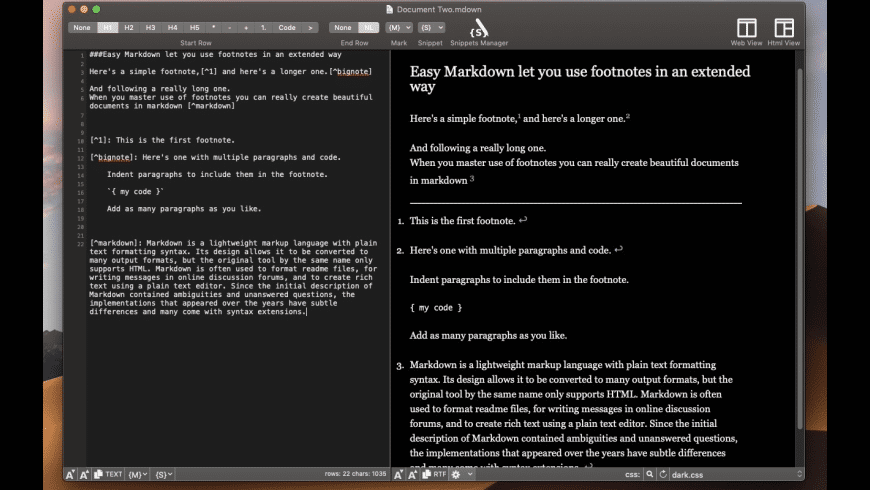Easy Markdown Tables with Table to Markdown In the original Markdown spec, John Gruber describes Markdown as 'a text-to-HTML conversion tool for web writers.' It was designed to be easy to read and easy to write, and it certainly meets those requirements. Compare writing a bold link in HTML. Markdown is often used to format readme files, for writing messages in online discussion forums, and to create rich text using a plain text editor. With Markdown Editor Free you can Easily create your Markdown syntax. Markdown Editor Free is a WYSIWYG „What You See Is What You Get“ Editor and easy to use. Markdown is a way to write content for the web. It’s written in what people like to call “plaintext”, which is exactly the sort of text you’re used to writing and seeing. Plaintext is just the regular alphabet, with a few familiar symbols, like asterisks (. ) and backticks ( ` ).
Weblog Publishing
Markdown Monster can also publish your Markdown directly to your Weblog. If your blog supports WordPress, MetaWeblog, Jekyll or Medium, you can publish your documents with one click. You can also edit and republish, or download existing posts and even convert existing posts from HTML to Markdown.
Extensible via .NET
We also wanted to make sure the editor is highly extensible, so you can add custom features of your own. Markdown Monster includes an addin model that makes it easy to build extensions that let you hook into the UI, the editor behavior and the publishing process. We also provide useful Scripting and Text Templating addins that let you automate many tasks without creating an addin. Find out more about creating an addin with .NET.
What our Users say
We work hard at building an editor that you love to use, and that provides you with the features you need. Your feedback matters and we'd love to hear your suggestions and see you get involved.
But don't take our word for it - here is what some of our users are saying about Markdown Monster:
Want to share your excitement for Markdown Monster? Tweet to @markdownmonstr and tell us how Markdown Monster improves your world.Markdown is a wonderfully simple approach to creating web pages, writtenby John Gruber of DaringFireball. You get on with the business of writing (without any fancycode) and Markdown takes care of producing clean, web standardscompliant HTML.
The Daring Fireball site provides full documentation forMarkdown, but the following examplesshould get you started.
Section Headings
You can define headings of different levels when creating a web page.The most important heading (which typically only occurs once on eachpage -- at the top) is heading 1. A level 1 heading can be created withMarkdown by typing a single '#' character at the start of a line. Theheading at the top of this page was defined like this:
To create a secondary heading (such as the one for this section) youjust use two '#' characters, like so:
You can use up to six '#' characters to create a level 6 heading, butyou will probably find that you don't need to nest your headings quiteso deeply!
Paragraphs
Paragraphs are very easy; separate them with a blank line. You can writeyour paragraph on one long line, or you can wrap the lines yourself ifyou prefer.
This section was marked up like so:
Bold and Italics

It's very easy to add emphasis with bold and italics:
You can also use underscores if you prefer:
Links
Create simple links by wrapping square brackets around the link text andround brackets around the URL:
If you want to give your readers an extra about the link that they'reabout to follow you can set a link title:
Titles usually appear as a tooltip when you hover over the link, andhelp search engines work out what a page is about.
Bulleted Lists
Start each line with hyphen or an asterisk, followed by a space. Listitems can be nested. This text:
Lips unsealed photos. ..produces this list:
- Bullet 1
- Bullet 2
- Bullet 2a
- Bullet 2b
- Bullet 3
Numbered Lists
Start each line with number and a period, then a space. This text…
..produces this list:
Easy Markdown Editor
- Baked potato
- Baked beans
- Pepper
Quotes
If you need to cite a paragraph of somebody else's work you really oughtto attribute it to them properly by using HTML's <blockquote/> tag.You can produce it with Markdown by adding a single '>' character atthe beginning of the line.
Easy Markdown Calculator
This text:
..produces:
One thing was certain, that the white kitten had had nothingto do with it -- it was the black kitten's fault entirely. Forthe white kitten had been having its face washed by the old cat,for the last quarter of an hour (and bearing it pretty well,considering) so you see that it couldn't have had any hand inthe mischief. -- Lewis Carroll, Through the LookingGlass
